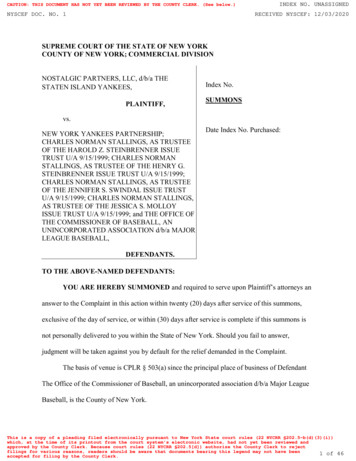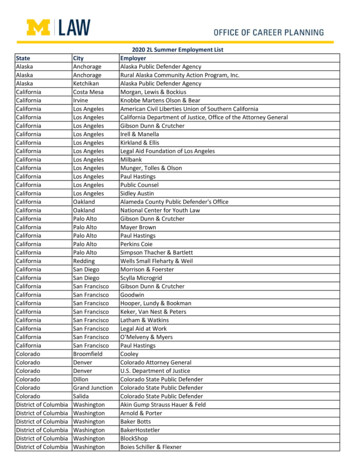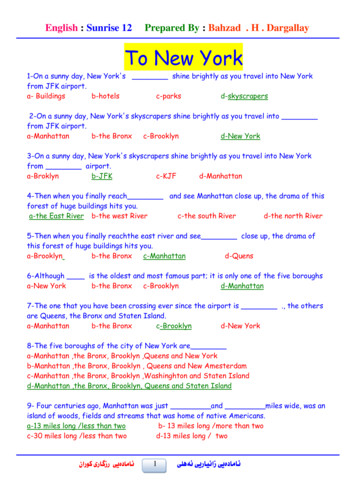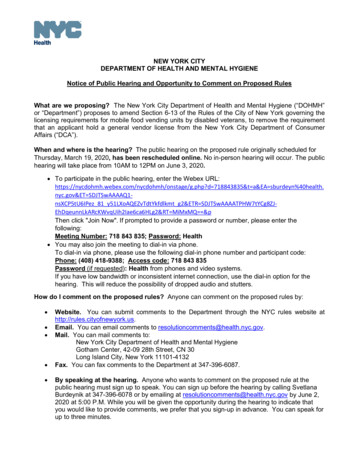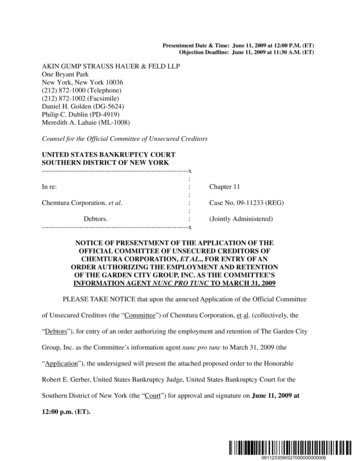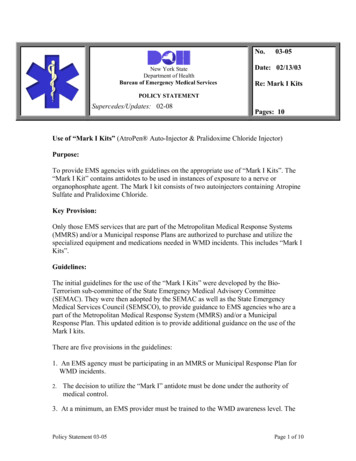
Transcription
No.New York StateDepartment of HealthBureau of Emergency Medical Services03-05Date: 02/13/03Re: Mark I KitsPOLICY STATEMENTSupercedes/Updates: 02-08Pages: 10Use of “Mark I Kits” (AtroPen Auto-Injector & Pralidoxime Chloride Injector)Purpose:To provide EMS agencies with guidelines on the appropriate use of “Mark I Kits”. The“Mark I Kit” contains antidotes to be used in instances of exposure to a nerve ororganophosphate agent. The Mark I kit consists of two autoinjectors containing AtropineSulfate and Pralidoxime Chloride.Key Provision:Only those EMS services that are part of the Metropolitan Medical Response Systems(MMRS) and/or a Municipal response Plans are authorized to purchase and utilize thespecialized equipment and medications needed in WMD incidents. This includes “Mark IKits”.Guidelines:The initial guidelines for the use of the “Mark I Kits” were developed by the BioTerrorism sub-committee of the State Emergency Medical Advisory Committee(SEMAC). They were then adopted by the SEMAC as well as the State EmergencyMedical Services Council (SEMSCO), to provide guidance to EMS agencies who are apart of the Metropolitan Medical Response System (MMRS) and/or a MunicipalResponse Plan. This updated edition is to provide additional guidance on the use of theMark I kits.There are five provisions in the guidelines:1. An EMS agency must be participating in an MMRS or Municipal Response Plan forWMD incidents.2.The decision to utilize the “Mark I” antidote must be done under the authority ofmedical control.3. At a minimum, an EMS provider must be trained to the WMD awareness level. ThePolicy Statement 03-05Page 1 of 10
awareness program should be a national training program or modeled after one of thetraining programs developed by the Department of Defense (DOD), Department ofJustice (DOJ) or Federal Emergency Management Agency (FEMA).An online WMD awareness course is offered through the Domestic PreparednessCampus of Texas A&M University’s web site at:http://www.teexwmdcampus.com4. The “Mark I Kit” is not to be used for self-administration or prophylaxis.5. Use of the “Mark I Kit” is to be based on signs and symptoms of the patient. TheSuspicion or identified presence of a nerve agent is not sufficient reason to administerthese medications.Antidote Mechanism of Action:1.The nervous system controls body functions by secreting chemicaltransmitters which act as “instructions” to nerves, muscles and glands atthe nerve endings.2.These neurological instructions come in two forms:1) stimulate (move or work)2) relax (stop or rest).3.When a nerve agent is present, it interferes with the normal instructions ofchemical transmitters that direct the muscle or gland to return to an unstimulated, relaxed state.4.By interfering with the normal chemical checks and balances, the action oftoxic nerve agents is to over-stimulate the nerve endings and centralnervous system.5.Over-stimulation of the nervous system causes muscles and certain glandsto over-react and cause the symptoms of: SLUDGEM Respirations andAgitation.6.The initial treatment for a nerve agent exposure consists of a two partantidote:1) Atropine, and2) 2-PAM Chloride.NOTE:ATROPINE IS THE PRIMARY DRUG FOR TREATMENT OFNERVE AGENT EXPOSURE!Policy Statement 03-05Page 2 of 10
7.Atropine stops the effect of the nerve agent by blocking the effects ofover-stimulation. It effectively counters the actions of the nerve agent atnerve receptors.8.Atropine relieves the smooth muscle constriction in the lungs (wheezing,respiratory distress) and gastrointestinal (diarrhea, cramps) tract, and alsodries up respiratory tract secretions.9.The companion drug to Atropine is 2-PAM CL; this drug complements theaction of Atropine. 2-Pam Chloride acts to restore normal functions at thenerve ending by removing the nerve agent and affecting toxinirreversibility. This antidote is effective at re-establishing normal skeletalmuscle contraction (relieves twitching and paralysis of respiratorymuscles).RECOMMENDED ANTIDOTE DOSING SCHEDULE FOR EXPOSURE TONERVE AGENT1.If severe signs and symptoms are present, three (3) Atropine auto-injectors andthree (3) 2-PAM CL injectors should be administered in rapid succession.2.If the patient exhibits SLUDGEM but no central nervous system (CNS) findingsare present, then two (2) Atropine auto-injectors and one (1) 2-PAM CL injectorshould be given.3.In either case, remove secretions, maintain patient’s airway and, if necessary andthe situation permits, use artificial ventilation.4.Repeat dosages will be given as specified in the Extended Re-evaluation andTreatment Schedule (Table 2).5.If symptoms resolve, then only monitoring is necessary.6.Pre-measured doses of auto-injectors should be safe in most adults. It should benoted, however that auto-injectors were designed for a military profile:approximate age 18-35, weight 70 kg. Or 154 lbs., healthy and with nopreexisting medical conditions.7.Pralidoxime (2-PAM CL) is most effective if administered immediately afterpoisoning and following but not before Atropine, especially for severe exposures.8.When the nerve agent has been ingested exposure may continue for some timedue to slow absorption from the lower bowel. Fatal relapses have been reportedafter initial improvement. Continued medical monitoring and transport ismandatory.Policy Statement 03-05Page 3 of 10
9.If dermal exposure has occurred, decontamination is critical and should be donewith standard decontamination procedures. Patient monitoring should be directedto the same signs and symptoms as with all nerve agent exposures.10.Diazepam (Valium) may be given cautiously if convulsions are not controlled.Antidote Dosing Schedules:Signs & SymptomsSevere RespiratoryDistress,AgitationSLUDGEMRespiratory Distress,SLUDGEMAsymptomaticNoneInitial Treatment (Table 1)Atropine DoseMonitor Interval2-Pam Dose3 Auto-injectors (6 mg)Monitor every 5 minutes3 Auto-injectors(1.8 gms)2 Auto-injectors (4 mg)Monitor every 10 minutesMonitor for signs &symptomsevery 15 minutes1 Auto-injector(600 mg)NoneIn the initial phase, triage will be initiated in the Hot Zone, continued in the warmzone, and performed only by trained personnel who are wearing appropriate PersonalProtective Equipment (as determined by the Incident Commander). Patientdecontamination will be simultaneous with and/or prior to treatment. Children shouldbe decontaminated and have expedited transport off scene especially if they aredemonstrating any signs and symptoms of exposure.Extended Re-Evaluation & Treatment Phase:This phase is reached once patients have been initially managed and patientvolume allows for more protracted patient assessments.Extended Re-evaluation and Treatment Schedule (Table 2)Atropine DoseMonitor Interval2 mgMonitor every 5minutesUp to a maximum of1.8 gms.(3 auto-injectors)Respiratory DistressSLUDGEM2 mgMonitor every 5to 15 minutesUp to a maximum of600 mg.(1 auto-injector)Atropine 5-10minutes as neededAsymptomaticNoneMonitor every 15minutesNoneAtropine 5-15minutes as neededSigns & SymptomsSevere Respiratory Distress,Agitation,SLUDGEMPolicy Statement 03-052 Pam DoseAtropine RepeatDosing FrequencyAtropine 3-5minutes asneededPage 4 of 10
Note: Personnel operating in this phase should be aware of the potential for “offgassing”. Off- gassing is the process by which vapors are given off bychemically contaminated clothing.Cautions For Use Of Auto-Injectors:1.Every potential exposure in the immediate vicinity of the incident must bemedically evaluated and monitored. Delayed symptoms may present anytimepost incident.Any patient ill enough to receive even one dose of atropine must be evaluatedat an appropriate facility (e.g. casualty collection point, hospital, etc.).2.Signs or symptoms of nerve agent poisoning may reappear. Serial observationsare a critical part of the management process.3.Auto injectors have been developed for use in the adult population. Safety andeffectiveness of 2-PAM CL in children has not been established. The atropineand 2-PAM CL antidote auto injectors should not be used in children 9 yearsof age or younger.For additional information on the treatment of pediatric patients contact medicalcontrol or refer to local REMAC developed protocols.Adverse Reactions:Note: Adverse reactions may occur but there are no contraindications to treatingsystematic patients.1.Atropine may cause chest pain. It may also exacerbate angina or induce amyocardial infarction.2.Up to one hour after intramuscular injection of 2-PAM CL some pain maybe experienced at the site of injection.3.2-PAM CL may cause blurred vision, double vision (diplopia), dizziness,headache, drowsiness, nausea, rapid heart rate (tachycardia), increasedblood pressure, and hyperventilation.4.Both (Atropine and 2-Pam CL) should be used with caution (but notwithheld) in patients with preexisting cardiac disease, high blood pressure,or strokes, particularly in the Extended Re-evaluation and TreatmentPhase.Auto-Injectors – General:Note: Use of antidotes will not protect responders from anticipated exposures.Policy Statement 03-05Page 5 of 10
1.Auto-injectors are self-contained, simple, compact injection systems thatcome equipped with a pre-measured dose (normal adult dose) of antidote.2.An antidote relieves, counteracts, or reverses the effects of poisons ordrugs such as nerve agents.3.The Mark I kit must be kept at room temperature (about 25 C 77 F) andmust be protected from freezing.4.Mark 1 antidote kits are to be used only:1)when specific signs and symptoms of exposure are presentAND2)the scene has been declared the site of a nerve agent releaseby a local competent authorityAND3)Following consultation with Medical Control and incompliance with any local REMAC Nerve Agent Protocol.a.b.The Mark 1 injectors are not to be used as a prophylaxis forpersonal protection.There is to be no self-administration of antidote.5.Auto-injectors permit rapid administration of antidote, prevent needlecross-contamination between patients, and enable rapid and accurateadministration to a large number of patients (even if the emergencyprovider and the patient are in chemical protective clothing).6.Auto-injectors facilitate treatment by providing simple, accurate, drugadministration of a pre-measured, controlled dose.7.Auto-injectors administer a predictable drug dose that is not operatordependent.8.Auto-injectors contain pre-measured doses of the nerve agent antidotes:1)Atropine2)2-PAM Chloride (2-PAM CL; pralidoxime chloride)9.Each auto-injector contains pre-measured amounts of Atropine (2 mg totaldose per injection) and 2-PAM CL (600 mg total dose per injection).10.Mark 1 antidote kits are available and are only to be used under thedirection of medical control in accordance with a local REMAC approvedPolicy Statement 03-05Page 6 of 10
Nerve Agent Exposure protocol. EMS agencies must be identified as aparticipant in a municipal response plan involving nerve agents.Directions For Use Of Auto-Injector1.When auto-injector use is indicated, the recommended procedure is toinject the contents of the auto-injector into the muscles of an anterolateral(front and side) thigh (through the pocket).2.Procedure:1)Remove safety cap (yellow on Atropine; gray on 2-PAM CL). Do not touch thecolored end of the injector after removing the safety cap.2)Caution: The injector can and will inject into the fingers or hand if anypressure is applied to either end of the injector.3)Hold injector as you would a pen. Place colored end (green on Atropine, Gray on2-PAM CL) on thickest part of thigh and press hard until injector is activated.4)Pressure automatically activates the spring, which plunges the needle into themuscle and simultaneously forces fluid (Atropine or 2-Pam CL) through it intothe muscle tissues.5)Hold firmly in place for ten seconds then remove. Massage the area ofinjection.6)After each auto-injector has been activated, the empty container should bedisposed of properly. It cannot be refilled nor can the protruding needle beretracted.IMPORTANT:Physicians and/or other medical personnel and emergencyresponders assisting evacuated victims of nerve agent exposureshould avoid exposing themselves to cross-contamination byensuring that they do not come into direct contact with thepatient’s clothing.Documentation: When a patient has received treatment with the use of a Mark I kit(s) there must be amethod to record such information so persons providing subsequent care are aware ofthat treatment and the amount of medication given. If the resources are present it is recommended that a triage tag be placed on eachpatient and that any treatment given be recorded on that tag.Policy Statement 03-05Page 7 of 10
If the patient is provided with care prior to decontamination than replace that triagetag following decontamination with a new (dry) tag and copy over any informationregarding treatments already provided. In the event triage tags are not available, documentation might be provided byaffixing a piece of medical tape on the patient indicating what care has been provided.Be sure that if such a system is used that any tape applied prior to decontamination isremoved as part of decontamination and the information is exactly copied on any newdocuments pertaining to the patient.Sample Protocol:Attached to this policy and guideline is a model “Mark I PROTOCOL” based uponexisting metropolitan response system protocols and various federal agencyrecommendations for administration. This protocol is not mandated and was notspecifically approved by the SEMAC. This protocol is provided to assist a RegionalMedical Advisory Committee (REMAC) or municipal system Medical Director indeveloping a local protocol. This model is not intended for independent use by anEMS agency. It may be used only with medical authorization and participation of theagency in a municipal or MMRS plan.There are currently five metropolitan areas that are part of the MMRS program in NewYork State:New York CityYonkersBuffaloRochesterSyracuseIf your agency is included in an MMRS or municipal response plan you may havereceived training and formal protocols for WMD response, including the use of the“Mark I Kits”. This guideline, if different from the plan in which you participate, is notmeant to supercede your local protocol, medical control or policy.This policy has been distributed to your REMAC, Regional EMS Councils and CountyEmergency Management authorities.Issued and Authorized by:Edward G. Wronski, DirectorBureau of EMSPolicy Statement 03-05Page 8 of 10
MODEL PROTOCOL FOR THE USE OF MARK I KITSPurpose: These are antidotes to be used in instances of exposure to a nerve ororganophosphate agent.Use: The Mark I is to be used only if you are part of the MMRS and or a MunicipalResponse Plan.Contents: (1) Atropine Auto-Injector ( 2 mg total dose per injection )(2) 2-PAM (2-PAM CL; pralidoxime chloride) 600 mgs. total dose perinjection. NOTE: These injectors are not to be used as a prophylactic modality. There is tobe no self-administration of the antidote.I: Mark I Kit(a) To be used only in a disaster situation and only if you are a part of the MMRS and ora Municipal Response system.(b) The Mark I Kit is only to be utilized under direct authority of Medical Control.II: Auto Injector Use(a) Pre measured doses in auto-injectors should be safe for most adults.(b) Atropine auto-injector and Pralidoxime (2 PAM CL) may be administered byqualified emergency personnel and designated emergency responders who have hadadequate training in on-site recognition and treatment of nerve and ororganophosphate agent intoxication in the event of a chemical release. This is specificto the disaster setting.(c) Medical treatment is directed to relieving respiratory distress and alleviating seizures.III: Indications for use of the Auto Injectors(a) It is a concern that the use of auto-injectors could lead to administration ofinappropriate and harmful doses during a non-chemical agent or minimal exposuresituations. The auto-injectors are to be used only if the patient presents withSLUDGEM RESPIRATIONS and AGITATION.(b) The Atropine and 2-PAM CL auto injectors should be used by qualified emergencymedical personnel and designated emergency responders only after the followingevents have occurred:1) The recognition of the existence of a potential chemical or organophosphate agentrelease in an area.2) Some or all of the symptoms of the nerve agent poisoning cited below are present:Policy Statement 03-05Page 9 of 10
SLUDGEM RESPIRATION and AGITATIONS – salivation (excessive drooling)L – lacrimation (tearing)U – urinationD – defecation / diarrheaG – GI upset ( cramps )E – emesis ( vomiting )M – muscle ( twitching, spasm, “bag of worms” ) RESPIRATION – difficulty breathing / distress ( sob, wheezing ) AGITATION CNS SIGNS – confusion, agitation, seizures, coma.3) Atropine must be given first, do not give anything else until the effects of atropinebecome apparent. Only when the effects of the atropine have been seen can you thengive 2 – PAM CL.4) If symptoms resolve, then only monitoring is necessary.5) If severe signs and symptoms are present; three (3) Atropine auto-injectors andthree (3) 2-PAM CL injectors should be administered in rapid succession(stacked).1.2.3.4.Remove secretionsMaintain an open airwayUse artificial ventilation in necessary and possibleRepeat Atropine immediately as directed6) Pralidoxime ( 2-PAM CL ) is most effective if administered immediately after thepoisoning but not before Atropine, especially for severe exposures.7) If available Diazepam ( Valium ) may be cautiously given, under direct medicalcontrol, if convulsions are not controlled.8) When the nerve agent has been ingested, exposure may continue for some time due toslow absorption from the lower bowel, and fatal relapses have been reported afterinitial improvement. Continued medical monitoring and transport is mandatory.9) If dermal exposure has occurred, decontamination is critical and should be done withstandard decontamination procedures. Patient monitoring should be directed to thesame signs and symptoms as with all nerve or organophosphate exposures.7/2/2002Policy Statement 03-05Page 10 of 10
Directions For Use Of Auto-Injector 1. When auto-injector use is indicated, the recommended procedure is to inject the contents of the auto-injector into the muscles of an anterolateral (front and side) thigh (through the pocket). 2. Procedure: 1) Remove safety cap (yellow on Atropine; gray on 2-PAM CL). Do not touch the




